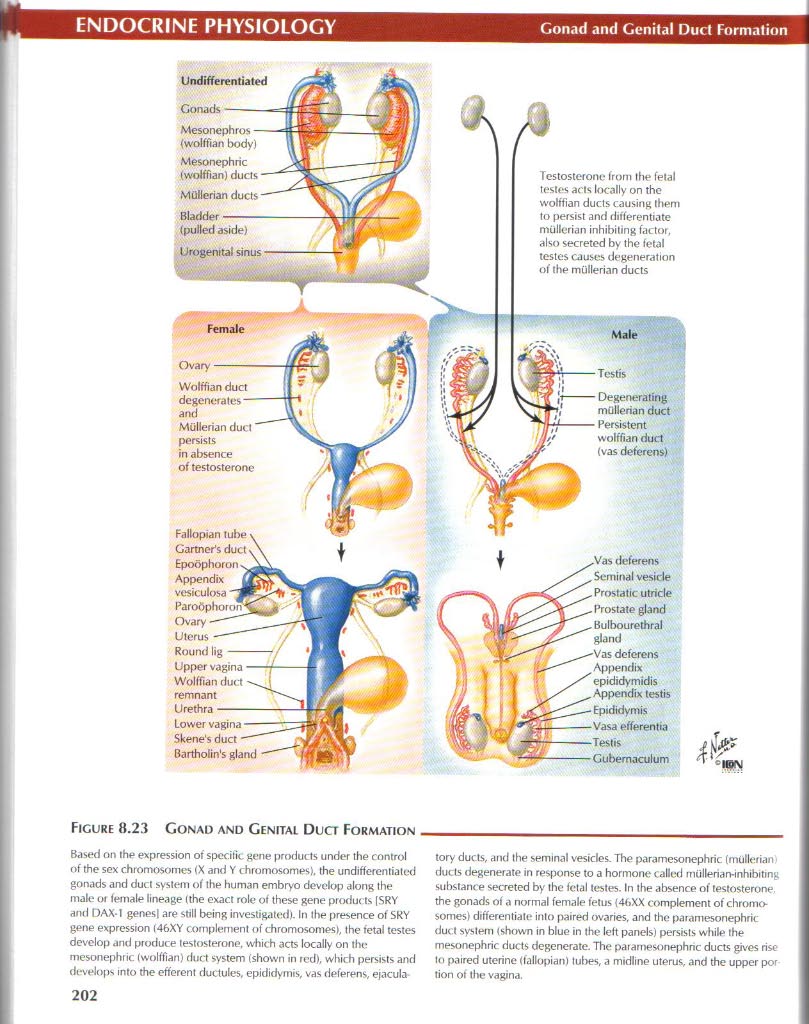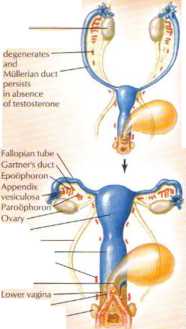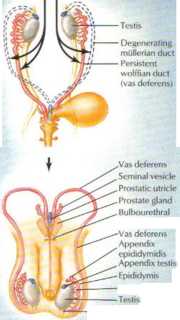netter183

ENDOCRINE PHYSIOLOGY
Gonad and Genital Duet Formation

(pulled aside)
I .‘rogemtoi
Testosterone from Ihe fetal testes acls locally on the wolffian ducts causing them to persist and differentiate mullerian inhibiting factor, also secreted by the fetal testes causes degeneration of the mullerian ducts
Female

Skenes duet BarthoIin's gland
Ovary Wolffian duet
Uterus Round lig Upper vagina Wolffian duet remnant Urethra


Figurę 8.23 Gonad and Genitał Duct Formation
Based on the expression of spodlić gene products under the control of the sex chromosomem (X and Y chromosomes). the undifferentiated gonads and duct system of the human embryo develop along the małe or female lineage (the exact role of these gene products |SRY and DAXI genesl are still being investigated). In Ihe presence of SRY gene expression (46XY complement of chromosomesthe fetal testes develop and produce testosterone, which acts locally on the mesonephric (wolffian) duct system (shown in red), which persists and develops into the efferent ductules, epididymis, vas deferens, ejacula-tory ducts, and the seminal vestdes. The paramesonephric (mullerian) ducts degenerate in response to a hormone called mullerian-inhibiting substance secreted by the fetal testes. In the absence of testosterone. the gonads of a normal female fetus (4f>XX complement of chromosomes) differentiate into paired ovaries, and the paramesonephric duct system (shown in blue in the left panels) persists while the mesonephric ducts degenerate. The paramesonephric ducts gives rise to paired uterine (tallopian) tubes, a midline uterus, and the upper por tion of the vagina.
202
Wyszukiwarka
Podobne podstrony:
netter132 GASTROINTESTINAL PHYSIOLOGY Appetite and Hunger Smell I Vcntomcdial hypothalami .offood 1
netter165 ENDOCRINE PHYSIOLOGY Posterior Pituilary: Oxytocin Oxyto<in pickcd up by capillaries of
netter167 ENDOCRINE PHYSIOLOGY Growth Hormone Increased linear growth : Decreased adiposity Increase
10723 netter177 ENDOCRINE PHYSIOLOGY Adrenal Medulla CH/-CH-COOH ganglia CH7-CH2-N
32301 netter173 ENDOCRINE PHYSIOLOGY Adrenal Cortical Hormones JOMN A,CRAC_ao -IBM fe &n
76657 netter188 ENDOCRINE PHYSIOLOGYHormonal Kugulation of thc Monstru.il Cyde Hormonal Reculation o
więcej podobnych podstron